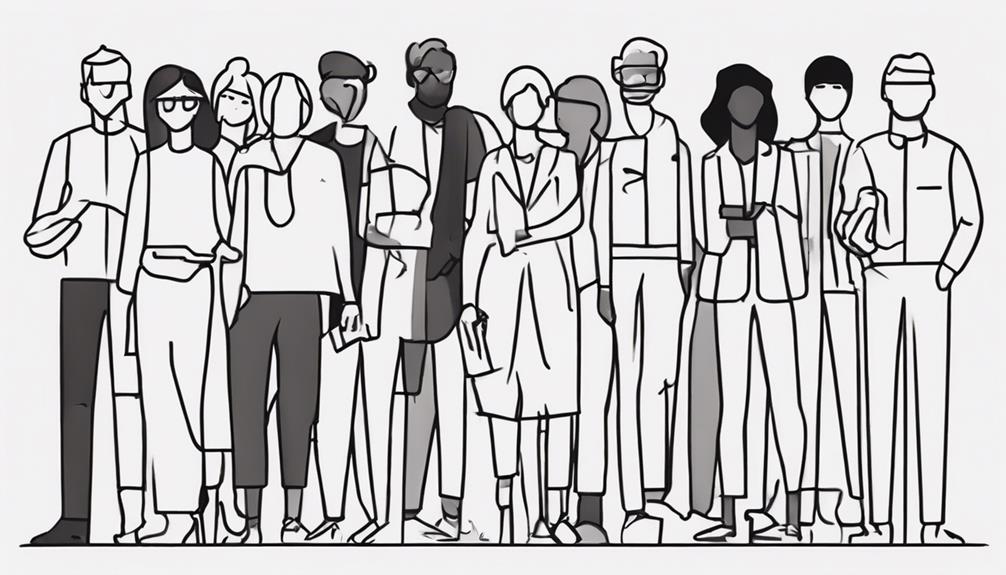Unemployment, a fundamental concept in economics, embodies more than just the absence of work. It intertwines with intricate factors shaping societies and economies worldwide. As we unravel the layers of what constitutes unemployment, we come to appreciate its multifaceted nature and the profound implications it carries. Exploring the depths of this phenomenon unveils a profound understanding of labor markets, economic dynamics, and societal well-being. Join us in dissecting the essence of unemployment and its far-reaching ramifications.
Key Takeaways
- Unemployment is a measure of joblessness in the economy, crucial for assessing labor market health.
- Different types of unemployment exist, each requiring specific interventions for mitigation.
- Government policies play a vital role in supporting job seekers and stabilizing the economy.
- Understanding unemployment helps in implementing effective strategies for economic stability and social welfare.
Understanding Unemployment

Unemployment, as defined by the U.S. Bureau of Labor Statistics, refers to individuals actively seeking employment but unable to secure suitable positions in the workforce. The Official Unemployment Rate is a key metric that quantifies this phenomenon. To be eligible for unemployment benefits, individuals must have lost their job through no fault of their own and meet specific criteria set by the government. These benefits provide temporary financial assistance to help workers meet their basic needs while they search for new employment opportunities.
The job market plays a crucial role in determining the level of unemployment, as it dictates the availability of suitable positions for job seekers. The government often implements various policies and programs to support workers in finding new job opportunities and to mitigate the adverse effects of unemployment on individuals and the broader economy. Understanding the complexities of unemployment, its impact on workers, and the mechanisms in place for providing support is essential for comprehending the dynamics of the labor market.
Significance of Unemployment
Unemployment holds significant importance as it directly impacts the economy and society. Understanding the economic repercussions of unemployment, the social consequences it brings, and the strategies governments employ to address this issue are crucial aspects of comprehending its significance in the broader context of societal welfare and economic stability. The economic impact of unemployment reverberates through various sectors, influencing production levels, consumption patterns, and overall economic growth.
Economic Impact of Unemployment
In the realm of economic dynamics, the phenomenon of unemployment exerts a significant influence on various facets of a nation's financial landscape. High levels of unemployment result in reduced consumer spending, leading to a decline in overall economic output. Additionally, governments experience decreased tax revenues and are compelled to allocate more funds towards social welfare programs, increasing government spending. Persistent joblessness can contribute to social unrest and economic instability, affecting the well-being of society as a whole. Conversely, low unemployment rates signify a strong economy but may also introduce inflationary pressures. Governments utilize unemployment data to make informed policy decisions and implement strategies to combat the challenges associated with unemployment.
Social Consequences of Unemployment
The ramifications of widespread unemployment extend far beyond economic implications, permeating deeply into the social fabric of communities and individuals.
- Unemployment can lead to increased poverty levels and financial instability, impacting individuals and families.
- It often results in social isolation, mental health issues, and a sense of loss of purpose or identity.
- Communities with high unemployment rates may experience higher crime rates and strained social services.
- Unemployment can exacerbate existing inequalities, contributing to social unrest and political instability.
Addressing the social consequences of unemployment is crucial for maintaining a stable and cohesive society. Understanding the interconnectedness of unemployment with social issues like mental health, poverty, and crime can help in developing comprehensive strategies to mitigate its impact on individuals and communities.
Government Responses to Unemployment
A critical component of economic governance involves crafting and implementing targeted policies to address fluctuations in labor market dynamics and mitigate the adverse effects of joblessness. Government responses to unemployment often include the provision of unemployment insurance to eligible individuals through various government programs. Eligibility requirements for such benefits are determined based on measures of labor underutilization, as reported by the Bureau of Labor Statistics. Understanding concepts and definitions such as frictional unemployment and discouraged workers is essential in formulating effective strategies to combat high unemployment rates. By implementing these policies, governments aim to support individuals during job transitions, minimize the negative impact of joblessness on society, and maintain economic stability amidst fluctuations in the labor market.
Categories of Unemployment
Among the various classifications of unemployment, voluntary and involuntary unemployment stand out as fundamental distinctions. Understanding these categories is crucial in dissecting the complexities of joblessness in the economy. Here are four key categories of unemployment:
- Voluntary Unemployment: Individuals choose to leave their current jobs voluntarily in pursuit of better opportunities elsewhere, leading to voluntary unemployment.
- Involuntary Unemployment: This category involves individuals who are involuntarily separated from their jobs due to layoffs, firings, or other reasons beyond their control, necessitating them to seek new employment.
- Frictional Unemployment: Arises from the time it takes for individuals to transition between jobs or when they are searching for their first job, creating temporary periods of unemployment.
- Cyclical Unemployment: Occurs due to fluctuations in the business cycle, with higher unemployment rates during economic downturns and lower rates during periods of growth.
Understanding these distinctions sheds light on the reasons behind joblessness and aids in formulating effective policies to address unemployment challenges.
Types of Unemployment

Different types of unemployment reflect various underlying causes that impact both individuals and the economy. Understanding these distinctions is crucial for implementing effective policies and solutions to address the diverse challenges posed by each type. Analyzing the causes, economic consequences, and potential interventions for different forms of unemployment provides a comprehensive framework for tackling this complex issue.
Causes of Unemployment
Unemployment manifests in various forms, each stemming from distinct underlying causes.
- Frictional unemployment arises due to job transitions, often temporary in nature.
- Cyclical unemployment fluctuates with economic cycles, peaking in times of recession.
- Structural unemployment occurs when technological changes displace workers from specific industries.
- Voluntary unemployment happens when individuals choose to leave jobs for various reasons.
Each type of unemployment, be it institutional or related to labor market incentives, plays a role in shaping the workforce landscape. By understanding these causes, policymakers and individuals can work towards addressing the challenges posed by different forms of unemployment.
Impact on Economy
The various types of unemployment, each rooted in specific causes, exert significant impacts on the economy, influencing its dynamics and performance. Frictional unemployment results from job transitions, impacting the percentage of the civilian workforce temporarily out of work. Cyclical unemployment varies with economic cycles, affecting consumer spending and overall economic health. Structural unemployment, driven by technological changes, creates skill mismatches between the workforce and available jobs. Additionally, institutional unemployment, influenced by government policies and regulations, introduces long-term challenges in the labor market. Understanding these types of unemployment is crucial for policymakers to implement targeted interventions and support measures that address the diverse needs of the unemployed population and foster a more stable and resilient economy.
Solutions and Policies
Analyzing and implementing effective policies and solutions to address the various types of unemployment is imperative for fostering a resilient and stable economy.
- Addressing frictional unemployment requires initiatives like job counseling services to facilitate smoother job transitions.
- To combat structural unemployment, retraining programs and investments in education are essential to equip workers with skills aligned with evolving market demands.
- Policies aimed at managing cyclical unemployment involve fiscal and monetary measures to stabilize the economy and stimulate job creation during economic downturns.
- Tackling institutional unemployment involves reforming labor market regulations and reducing barriers to entry for marginalized groups to promote inclusivity and equal opportunities in the workforce.
Effects on People and Economy

How does the impact of joblessness extend beyond individuals and families to affect the broader economic landscape? Unemployment not only leads to financial hardship, stress, and anxiety for individuals and their families but also has far-reaching consequences on the economy. The reduction in consumer spending resulting from joblessness directly impacts businesses, hindering economic growth. Moreover, high unemployment rates strain social welfare programs and necessitate increased government spending to support those without jobs. Long-term unemployment can exacerbate the situation by causing skills deterioration, making it harder for individuals to reintegrate into the workforce successfully.
Furthermore, unemployment contributes to a decrease in tax revenue, affecting the government's ability to fund essential services and programs. This reduction in tax revenue, coupled with the strain on social welfare programs and increased government spending, hampers economic growth and prosperity at a national level. Understanding these effects is crucial in developing effective policies to mitigate the impact of unemployment on both individuals and the economy.
Measurement and Statistics
Unemployment rate, derived from the ratio of unemployed individuals to the labor force, serves as a key indicator for assessing the health of the labor market. When discussing the measurement and statistics of unemployment, several crucial points come to light:
- Data Collection: The U.S. Bureau of Labor Statistics conducts the monthly Current Population Survey (CPS) to gather unemployment data, surveying approximately 60,000 households to provide a representative sample of the U.S. population.
- Policy Informant: Unemployment data is essential for policymakers to make informed decisions and understand the health of the labor market, guiding interventions and strategies to address unemployment challenges effectively.
- Additional Insights: Different measures of unemployment, such as the labor force participation rate and employment-population ratio, offer additional insights into the job market beyond the standard unemployment rate.
- Technological Impact: Technological change has influenced how unemployment is measured and understood, with new methodologies and tools shaping the assessment and response to labor market dynamics.
Frequently Asked Questions
What Is the Simple Definition of Unemployment?
Unemployment, a pivotal economic measure, denotes joblessness within a labor force actively seeking employment. The unemployment rate, calculated by dividing the number of unemployed individuals by the labor force, signifies job market conditions. It impacts social welfare, workforce participation, and the availability of employment opportunities. Understanding this concept is crucial for assessing the economic impact of job search dynamics and workforce dynamics, aiding policymakers, economists, and individuals in navigating labor market challenges effectively.
How Do You Explain Unemployment?
Economic impact, job search, labor force, unemployment rate, government assistance, job market, underemployment issues, and social consequences are all crucial aspects when explaining unemployment. Unemployment affects individuals, families, and entire economies. It can result in financial strain, reduced consumer spending, and social challenges. Understanding the complexities of unemployment involves analyzing its ripple effects on various sectors and implementing strategies to mitigate its detrimental consequences.
What Are the 4 Main Type of Unemployment?
In the realm of labor economics, the four primary types of unemployment are frictional, structural, cyclical, and seasonal. Frictional unemployment arises from temporary job transitions as individuals engage in job searches. Structural unemployment results from shifts in the labor market due to technological advancements or economic transformations. Cyclical unemployment is intricately tied to economic cycles, peaking during recessions. Seasonal unemployment occurs due to fluctuations in demand based on seasonal factors, impacting specific industries.
What Unemployment Does to You?
Emotional stress, financial strain, loss of confidence, and career setbacks are common consequences of unemployment. Social isolation, mental health challenges, constant job search efforts, and future uncertainty further compound the impact. Individuals may experience a profound sense of instability and inadequacy, highlighting the crucial need for comprehensive support systems and effective employment strategies. Addressing these multifaceted challenges is essential to mitigate the detrimental effects of unemployment on individuals and society.
Conclusion
In conclusion, unemployment is a critical economic indicator that reflects the overall health of an economy. Like a barometer measures atmospheric pressure, the unemployment rate measures the state of joblessness within a population. Understanding the different categories and types of unemployment, as well as its effects on individuals and the economy, is essential for policymakers and stakeholders to address and mitigate its negative consequences. Proper measurement and analysis of unemployment statistics are crucial for informed decision-making and effective policy implementation.
